Bhutan’s population is culturally diverse yet united under strong national traditions and Buddhist principles. Here’s an overview of the people and religion of Bhutan:
People
- Ethnic Groups: Bhutan has three primary ethnic groups:
- Ngalops: Primarily in western and northern Bhutan, the Ngalops are considered the descendants of Tibetan settlers. They are largely followers of Tibetan Buddhism, which strongly influences Bhutanese culture, language, and religious practices.
- Sharchops: The largest ethnic group in Bhutan, Sharchops live mainly in the eastern regions and are thought to be the country’s indigenous people. They primarily practice Buddhism, but some also follow the animistic Bon religion.
- Lhotshampa: Predominantly in southern Bhutan, Lhotshampas are of Nepalese origin and mostly follow Hinduism. This group immigrated to Bhutan in the late 19th century and has played a significant role in Bhutanese agriculture and trade.
- Languages:
- Dzongkha is the national language and is spoken mainly by Ngalops. It is also the language of the government and the legal system.
- Bhutan is linguistically diverse, with over 19 languages and dialects spoken across regions. Sharchops often speak Tshangla, while Lhotshampas speak Nepali.
- Way of Life: Bhutanese society is highly community-oriented and deeply values family bonds. Traditional dress—gho for men and kira for women—is widely worn and is mandatory in many official settings, reinforcing a sense of cultural identity.
- Social Structure: Bhutanese society emphasizes equality and mutual respect, with Buddhist values encouraging compassion and harmony. Family ties, loyalty, and community well-being are deeply ingrained.
Religion
- Buddhism:
- Dominant Faith: Buddhism, specifically Vajrayana Buddhism, is the state religion and is practiced by about 75% of the population. It is integral to Bhutanese identity, culture, and government, guiding daily life, art, architecture, and festivals.
- Key Beliefs: Bhutanese Buddhists follow the principles of compassion, karma, and reincarnation. The king is seen as a protector of the religion, and monasteries and monks play a central role in religious and public life.
- Sacred Sites: Bhutan has many monasteries and dzongs (fortresses) such as Tiger’s Nest Monastery and Punakha Dzong, which hold spiritual and historical significance. These places serve as centers of worship and gatherings for festivals.
- Festivals: The Bhutanese celebrate vibrant tsechus (religious festivals) in honor of Guru Rinpoche, who introduced Buddhism to Bhutan in the 8th century. These festivals feature masked dances, rituals, and blessings, which are believed to bring merit and good fortune to attendees.
- Hinduism:
- Followers: Primarily practiced by the Lhotshampa population in the south, Hinduism constitutes about 22% of the population’s faith.
- Religious Observance: Hindu festivals such as Dashain and Tihar are celebrated with public holidays. Hindu temples can be found in southern Bhutan, and the practice of Hinduism is respected and supported in Bhutan’s multi-faith society.
- Bon and Animistic Traditions:
- Bon: An ancient animistic faith predating Buddhism, Bon is practiced by a small section of Bhutanese, especially in the east. Some Buddhist practices, such as the use of prayer flags and certain rituals, are influenced by Bon traditions.
- Animism: Many Bhutanese believe in spirits inhabiting mountains, rivers, and trees, with offerings and rituals performed to appease these spirits. Nature worship is especially strong in rural areas and reflects Bhutan’s deep connection to the environment.
Summary
Bhutanese people live in a harmonious blend of traditional values and spiritual practices. Vajrayana Buddhism is central to life in Bhutan, informing values, culture, and law, while Hinduism and animistic traditions add to the country’s rich spiritual diversity. The people’s deep respect for the environment, their community-centered lifestyle, and strong religious roots create a unique cultural and spiritual identity for Bhutan.

